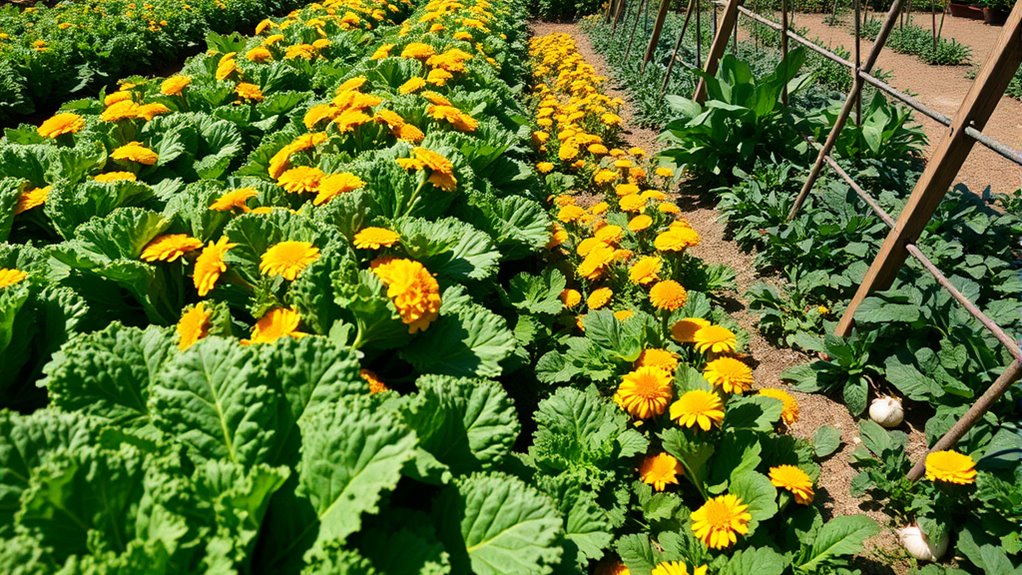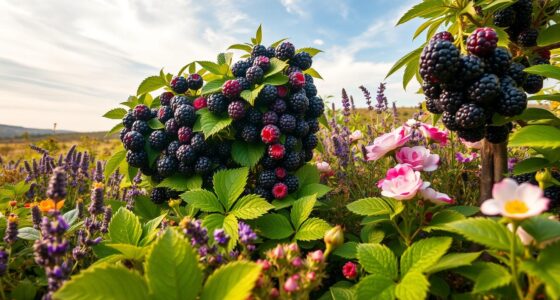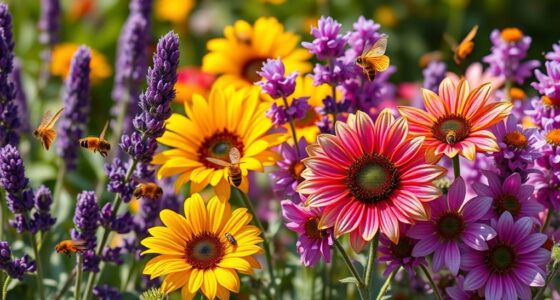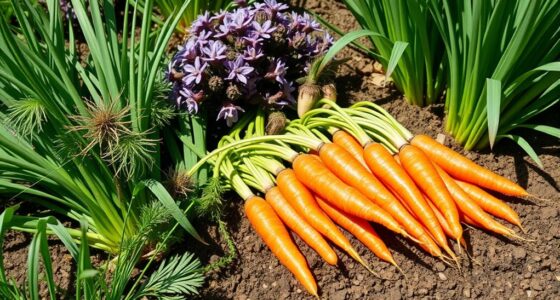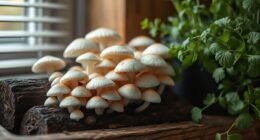To prevent pests, diseases, and growth issues, avoid planting tomatoes with corn, as pests can spread easily. Keep beans away from onions because their strong aroma can inhibit growth. Don’t grow cabbage near strawberries, and avoid pairing carrots with dill to prevent flavor transfer and pest attraction. Also, don’t place peppers next to fennel or melons near eggplants, as these combinations cause competition or chemical interference. Continue exploring to discover more tips for healthy, productive plant pairings.
Key Takeaways
- Avoid planting tomatoes and corn together to prevent pest spread and competition for sunlight and nutrients.
- Keep cabbage and strawberries separate to reduce pest transfer and soil-borne disease risks.
- Do not plant fennel near peppers or carrots due to growth-inhibiting chemical interference.
- Separate garlic and onions from asparagus to prevent nutrient competition and disease transmission.
- Avoid pairing dill with carrots, as dill’s aroma can cause flavor transfer and attract pests.
Avoid Planting Tomatoes and Corn Together
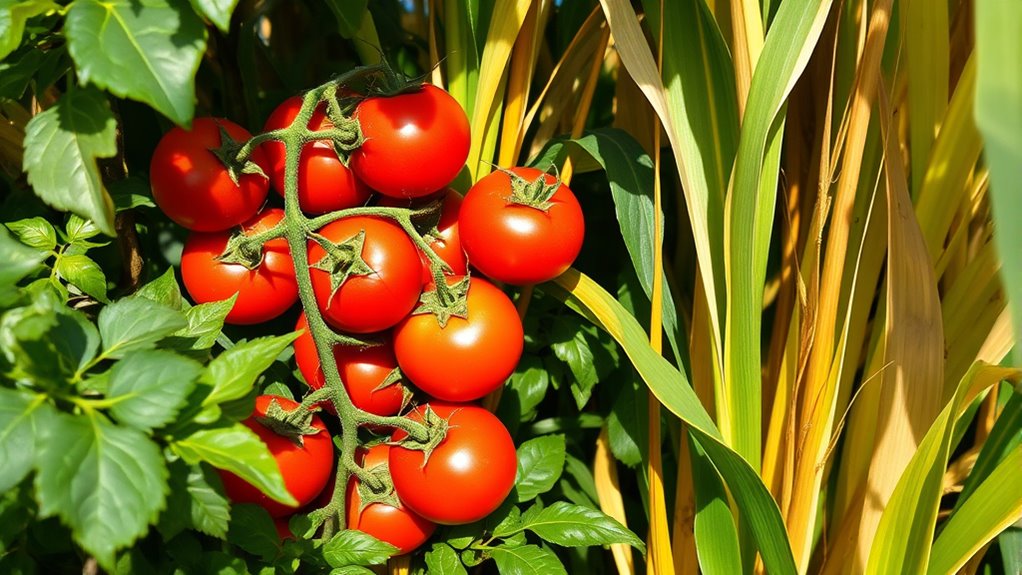
While planting tomatoes and corn together might seem convenient, it’s best to avoid this combination because corn can attract pests that also target tomatoes. Corn attracts corn earworms and other pests that can easily spread to nearby plants. These pests can cause significant damage to tomato crops, leading to reduced yields and increased pest control efforts. Additionally, corn can shade tomato plants, limiting their access to sunlight, which they need for healthy growth. The competition for nutrients can also hinder tomato development. Moreover, planting these crops together can facilitate the spread of pest problems, making it more challenging to manage infestations effectively. To keep both plants healthy and thriving, it’s smarter to plant them separately. This reduces pest problems and ensures each crop gets enough sunlight and nutrients, promoting better growth and higher yields. Implementing companion planting strategies can help optimize crop health and productivity by choosing compatible plants. Being aware of plant compatibility can further improve your garden’s success. Additionally, understanding pest attractants can aid in developing effective pest management strategies. Recognizing plant-pest relationships can also guide you in selecting the best companion plants to deter pests naturally.
Don’t Combine Beans and Onion Crops
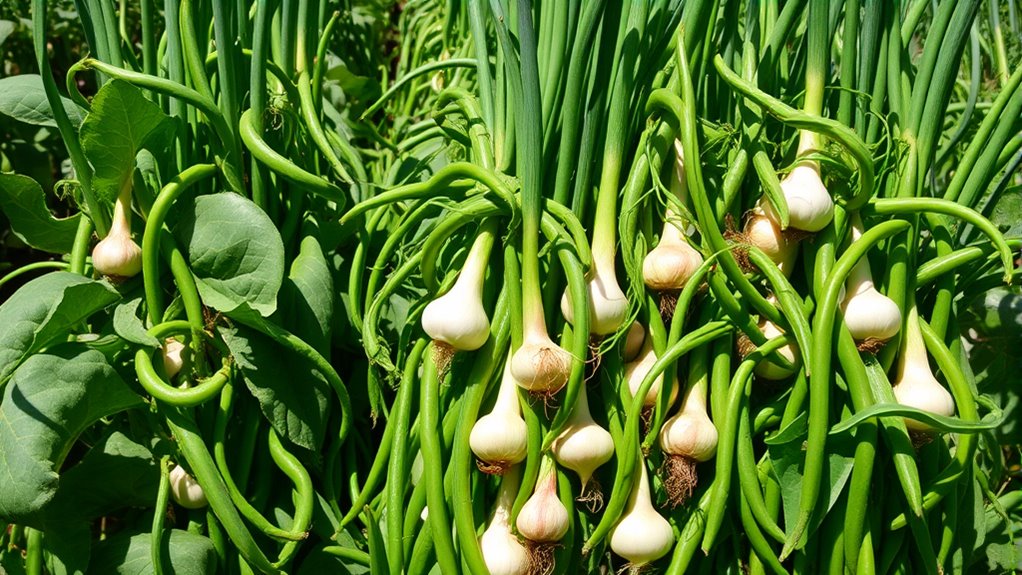
You should avoid planting beans and onions together because onions can release substances that inhibit the growth of beans. When you plant these crops nearby, the sulfur compounds in onions can create an unfavorable environment for beans to thrive. Onions may also interfere with the nitrogen-fixing process that beans rely on, reducing their overall health and yield. Additionally, onions tend to emit strong odors that can repel beneficial insects or attract pests that harm beans. If you’re aiming for a healthy, productive garden, it’s best to keep these two crops separate. By doing so, you prevent any negative chemical interactions and allow each plant to grow *preferably* without competition or interference. This simple spacing can make a *favorable* difference in your garden’s success. Understanding plant interactions can help you optimize your planting strategy for better yields. Recognizing the importance of companion planting can further enhance your garden’s health and productivity. Proper crop selection and spacing, guided by plant compatibility, are essential for a thriving garden. Incorporating knowledge of plant interactions can also aid in preventing pest issues and promoting overall plant health. Furthermore, understanding soil chemistry can help you select the most compatible crops for your garden’s conditions.
Keep Cabbage Away From Strawberries
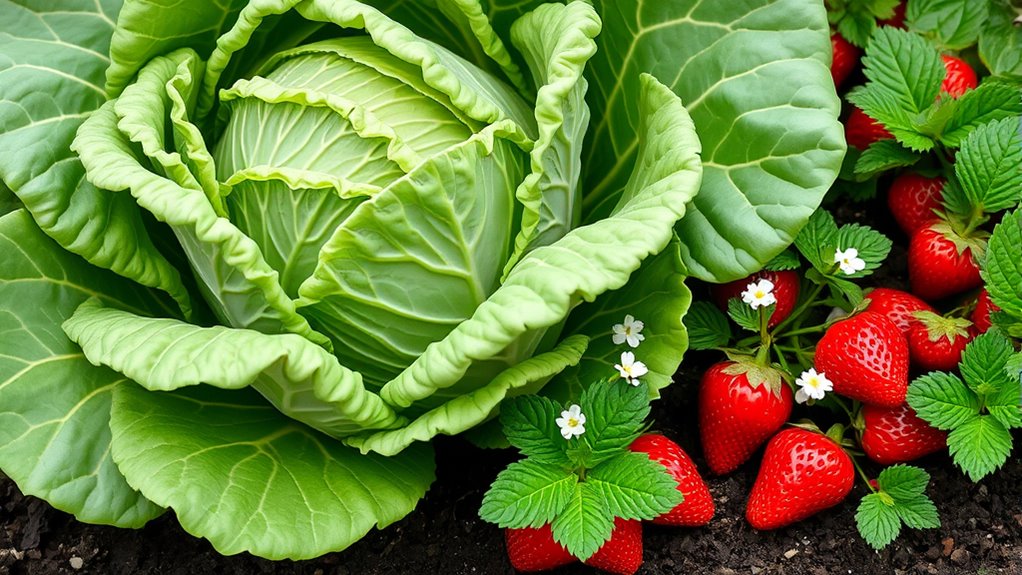
Keeping cabbage and strawberries apart helps prevent potential issues that can hinder the growth of both crops. Cabbage attracts pests like cabbage worms and aphids, which can easily spread to strawberries, leading to infestations that damage both plants. Additionally, cabbage is a heavy feeder, competing for nutrients and water, which can deprive strawberries of essential resources. Strawberries prefer slightly acidic, well-drained soil, while cabbage thrives in more neutral conditions; planting them together can disrupt soil balance. Furthermore, strawberries are susceptible to diseases such as verticillium wilt, which cabbage plants can harbor, increasing the risk of infection. To keep both healthy and productive, maintain a safe distance between cabbage and strawberries, reducing pest transfer and soil competition. This simple separation supports stronger, more resilient plants. Proper crop spacing is crucial for plant health and maximizing yields. Incorporating crop rotation practices can also help prevent soil-borne diseases and pest buildup, further safeguarding your crops. Additionally, understanding the beneficial and harmful plant interactions can guide you in selecting optimal planting arrangements for a healthy garden. Moreover, soil compatibility plays a significant role in ensuring both crops thrive without adverse effects.
Refrain From Growing Carrots Near Dill
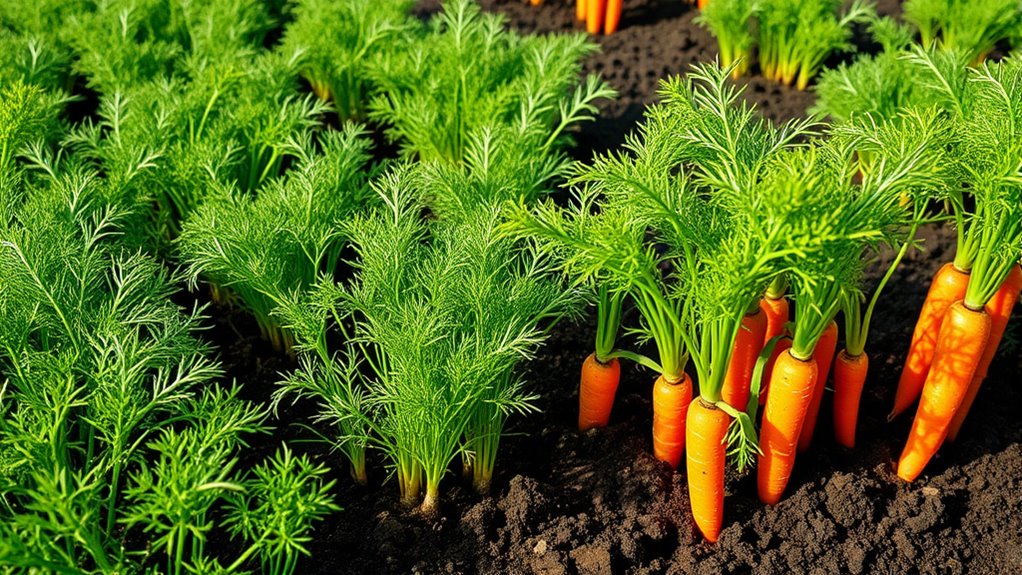
Growing carrots near dill can cause flavor transfer, making your carrots taste off. It may also attract pests that target both plants, increasing your risk of infestations. Additionally, dill can interfere with carrot growth, leading to smaller or misshapen roots. Proper companion planting considers plant compatibility to ensure healthy crops and avoid issues. To optimize growth, understanding the plant interactions can help prevent unintended consequences in your garden. Being aware of plant chemistry can further assist in selecting compatible companions. Recognizing plant signals can also guide gardeners in choosing the best plant pairings for a thriving garden. Moreover, considering plant growth cycles can help prevent competition and promote balanced development.
Flavor Transfer Risks
Planting carrots and dill close together can lead to unintended flavor transfer, which may alter the taste of both crops. Dill’s strong aroma and essential oils can seep into nearby carrots, giving them a bitter or off-flavor. Conversely, carrots can absorb compounds from dill, changing their natural sweetness and crispness. This cross-contamination can compromise the quality of your harvest, especially if you prefer pure, unaltered flavors. To maintain the integrity of each crop’s taste, keep dill and carrots at a safe distance. Avoid interplanting them in the same bed or even nearby rows. Additionally, growing conditions such as soil and moisture levels can influence flavor transfer, so maintaining optimal conditions helps preserve each plant’s unique taste. Proper plant separation is key to preventing flavor contamination and ensuring your carrots and dill develop their distinctive, natural tastes without interference. Regular monitoring and adjusting watering practices can further reduce the risk of flavor crossover by minimizing stress on the plants that might promote volatile compound transfer. Being aware of plant interactions can also help you design your garden for better flavor preservation.
Pest Attraction Concerns
When you keep dill and carrots close together, you might unintentionally invite pests that target one crop and spread to the other. Carrots attract carrot rust flies, while dill can bring aphids and spider mites. If pests settle on dill, they can easily move to carrots, causing damage. To prevent this, avoid planting dill directly beside carrots. Here’s a quick look at pest risks:
| Pest | Affected Crop | How It Spreads |
|---|---|---|
| Carrot rust fly | Carrots | Lays eggs near carrot roots |
| Aphids | Dill & Carrots | Feed on sap, spread quickly |
| Spider mites | Dill & Carrots | Thrive in dry, warm conditions |
| Cutworms | Both | Cut stems at soil level |
Keeping these pests in mind helps protect your garden’s health. Additionally, understanding integrated pest management strategies can help gardeners learn about effective control methods and digital literacy programs can provide valuable resources for pest identification and prevention. Being aware of pest behavior patterns is essential for timely intervention and maintaining a healthy garden ecosystem.
Growth Interference Issues
Although dill and carrots are often grown in the same garden, planting them too close can cause growth interference issues. Dill’s tall, feathery foliage can overshadow carrots, limiting sunlight and airflow. This can slow carrot development and increase disease risk. Additionally, dill’s roots may compete with carrots for nutrients, stunting their growth. Dill also attracts pests that could damage carrots, further hindering their progress. To avoid these problems, keep a good distance between the two. Consider these tips:
- Plant dill at least 12 inches away from carrots
- Ensure proper spacing for airflow and sunlight
- Monitor for pest activity early
- Avoid planting dill directly beside carrot rows
- Use raised beds or separate sections for each plant
This approach helps both plants thrive without growth interference issues.
Don’t Plant Peppers and Fennel Side by Side
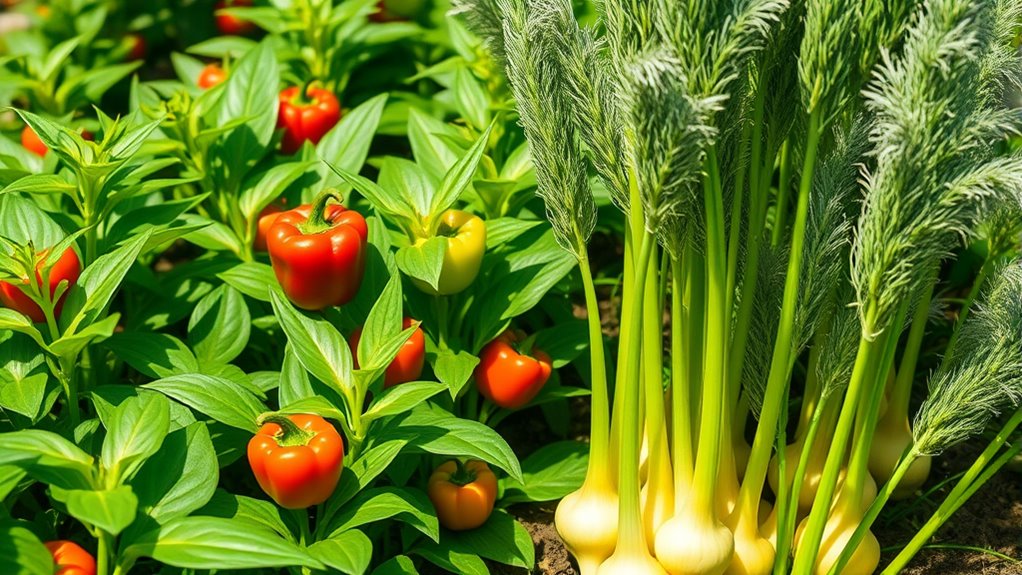
Planting peppers and fennel together can cause problems because fennel releases chemicals that hinder nearby plants. These allelopathic effects may suppress your pepper plants’ growth and reduce your harvest. To keep your garden healthy, it’s best to avoid placing these two side by side.
Fennel’s Allelopathic Effect
Fennel releases allelopathic compounds that can inhibit the growth of nearby plants, including peppers. These natural chemicals suppress seed germination and root development, making it difficult for peppers to thrive when planted close to fennel. You might notice stunted growth or poor yields if you ignore this warning. To avoid these issues, steer clear of planting fennel near peppers altogether. Keep in mind:
- Fennel’s chemicals spread through the soil, affecting other plants
- It can stunt pepper seed germination
- Fennel’s presence may cause weak or malformed pepper plants
- The allelopathic effect can last for multiple growing seasons
- Avoid planting fennel within close proximity to peppers for healthy growth
Being aware of fennel’s influence helps you create a more successful, balanced garden.
Pepper Growth Suppression
To guarantee healthy pepper growth, it’s essential to keep fennel far away from your pepper plants, as their proximity can substantially hinder development. Fennel releases chemicals that can stunt pepper growth and reduce fruit production. When planted nearby, fennel’s allelopathic properties interfere with pepper’s nutrient uptake and overall health. You might notice smaller peppers, slower growth, or even flowering issues. These negative effects aren’t just temporary; they can weaken your plants over time, making them more susceptible to pests and diseases. To ensure a strong harvest, avoid placing fennel within several feet of peppers. Instead, choose companions that support each other’s growth or leave fennel isolated in a different part of your garden. Keeping them apart ensures your peppers thrive and produce abundantly.
Steer Clear of Potatoes and Sunflowers Together
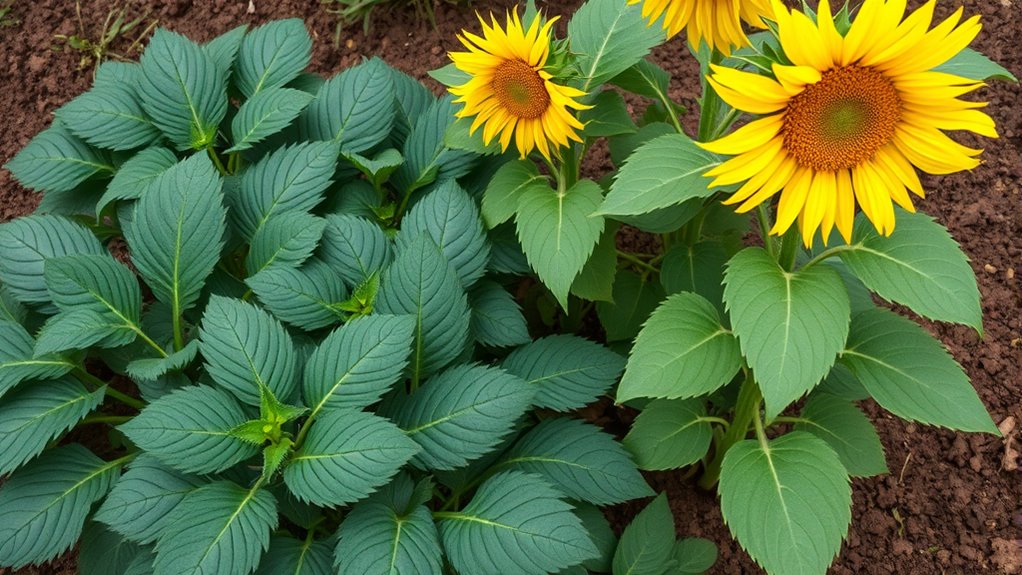
Although it might seem beneficial to grow potatoes and sunflowers nearby for aesthetic or practical reasons, combining these two plants can cause problems. Sunflowers attract pests like aphids and beetles, which can easily transfer to potatoes, increasing disease risk. Their tall, dense growth may shade the potatoes, leading to poor tuber development. Sunflowers also release allelopathic chemicals that can inhibit potato growth. Additionally, both plants compete for similar nutrients, stressing your garden’s soil. Here’s what to watch out for:
- Pest attraction and transfer
- Excessive shading of potatoes
- Allelopathic chemical interference
- Nutrient competition
- Increased disease susceptibility
Avoid planting these together to maintain healthy, productive crops and prevent pest and disease issues.
Avoid Mixing Melons With Eggplants
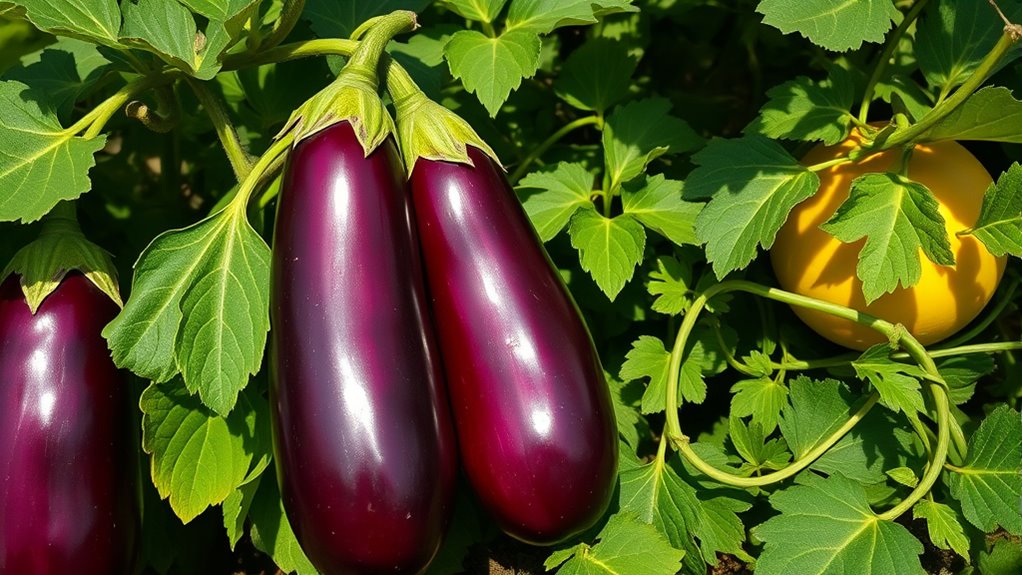
Planting melons and eggplants together can lead to several issues that hinder your garden’s health. Melons are vining plants that need ample space and good airflow, while eggplants prefer more stable, upright growth. When grown together, melons can overshadow eggplants, reducing airflow and increasing humidity around the plants. This creates a perfect environment for fungal diseases like powdery mildew and blight. Additionally, they compete for nutrients and water, which can stunt growth and lower yields for both crops. Melons also attract pests such as squash bugs and aphids, which can spread to eggplants, increasing pest problems. To keep your garden healthy and productive, it’s best to separate these plants and give each the space and conditions they need to thrive.
Don’t Grow Broccoli Near Kale or Other Brassicas

Growing broccoli near kale or other brassicas can increase the risk of disease transmission and pest attraction. These plants share common pests and pathogens, making it easier for problems to spread quickly. To protect your crops, keep brassicas separated and monitor them closely.
Disease Transmission Risks
Have you ever considered how proximity between certain crops can spread diseases? When you plant broccoli near kale or other brassicas, you risk transmitting diseases like black rot or clubroot. These pathogens can survive in the soil and infect neighboring plants easily. To reduce this risk, avoid placing brassicas close together.
- Disease spores can transfer through soil contact or splashing rain
- Close planting creates a humid environment, fostering disease development
- Pathogens can persist in the soil for years, impacting future crops
- Regular crop rotation helps prevent disease buildup
- Maintaining proper spacing improves airflow and reduces humidity
Pest Attraction Concerns
When you place broccoli close to kale or other brassicas, you not only risk disease spread but also attract pests that target these crops. Pests like cabbage worms, aphids, and flea beetles are drawn to brassicas, and having them nearby makes it easier for these pests to find their preferred plants. This proximity can lead to infestations that spread quickly between your crops, reducing yields and damaging plants. Additionally, pests that attack broccoli may also target kale, compounding your pest management challenges. To protect your garden, keep broccoli and other brassicas separate from kale and similar crops. This simple separation helps minimize pest attraction and keeps your plants healthier and more resistant to infestations.
Keep Asparagus Away From Garlic and Onions
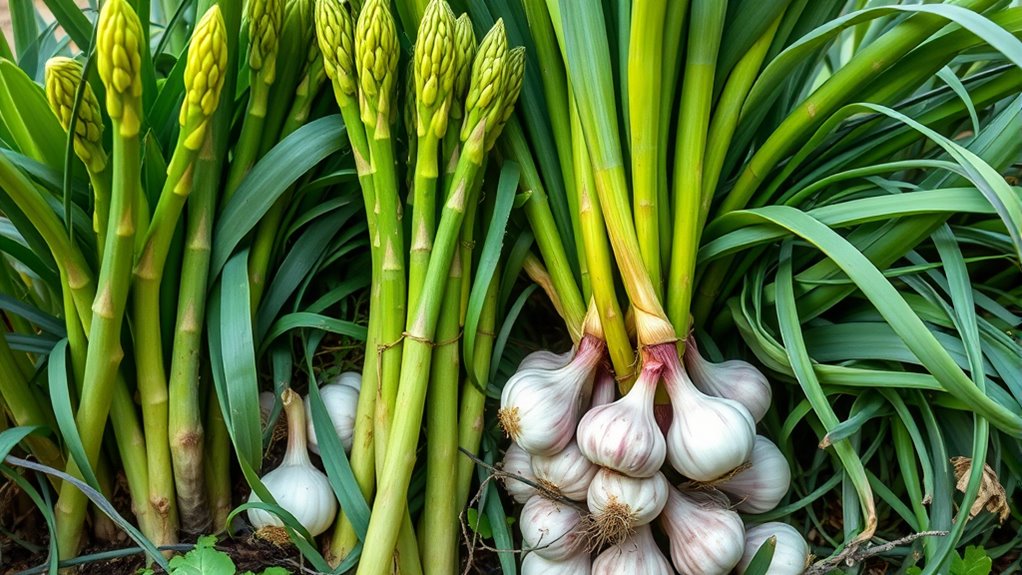
Although asparagus and garlic or onions are popular garden staples, planting them nearby can cause problems. Garlic and onions release compounds that may inhibit asparagus growth, reducing your harvest. Additionally, their strong scents can confuse pests, making it harder to detect issues. Keep these plants separate to prevent nutrient competition, as both need different soil conditions. Garlic and onions can also attract pests that might target asparagus. Finally, planting them together could lead to disease spread, like fungal infections, due to close proximity. To avoid these issues, consider these points:
Avoid planting garlic or onions near asparagus to prevent growth inhibition and pest issues.
- Garlic and onions may stunt asparagus growth
- Their scent can interfere with pest control
- Nutrient competition may limit yields
- Pests attracted to one can spread to the other
- Disease transmission risk increases when planted together
Refrain From Planting Lettuce Near Cabbage and Its Relatives
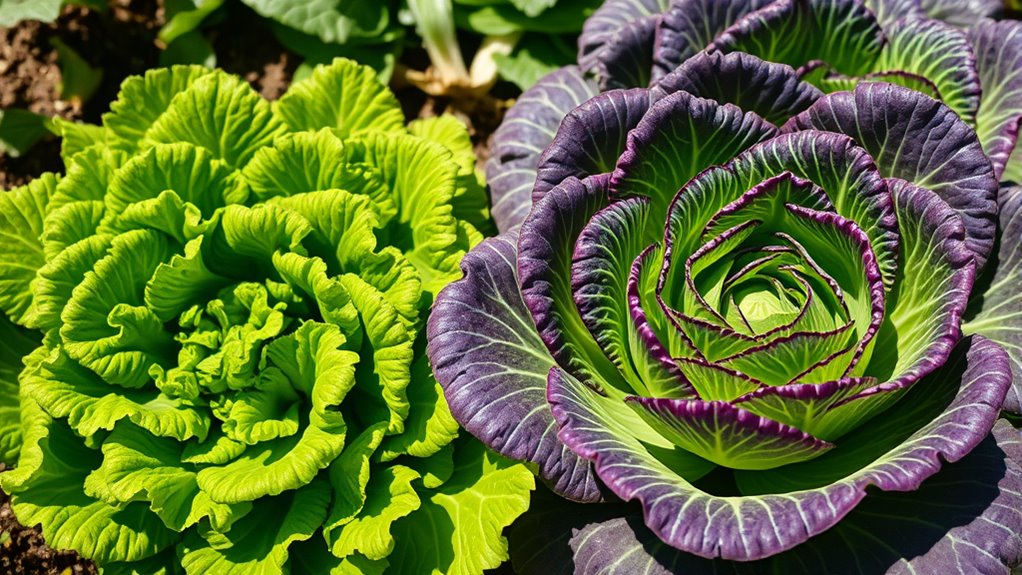
Planting lettuce too close to cabbage and its relatives can cause several issues that diminish your garden’s productivity. Lettuce and cabbage compete for similar nutrients and space, leading to stunted growth for both. Lettuce is a quick-growing, shallow-rooted plant that can be overwhelmed by the deeper, more aggressive roots of cabbage family plants. Additionally, cabbage and its relatives are prone to pests like aphids and cabbage worms, which can spread to lettuce if planted nearby. This proximity increases the risk of pest infestation and disease transmission. To keep your garden healthy and productive, avoid placing lettuce directly next to cabbage, broccoli, cauliflower, or kale. Giving these plants space helps prevent competition and pest issues, ensuring both crops thrive.
Frequently Asked Questions
Why Should Certain Vegetables Be Kept Apart in Companion Planting?
You should keep certain vegetables apart because some plants release chemicals or attract pests that can harm others. For example, planting onions near beans can hinder their growth, while garlic deters pests that might target cabbage. By understanding these interactions, you prevent issues like disease spread or pest infestation, ensuring your garden thrives. Proper separation helps each plant grow healthy and produces a better yield.
Are There Any Benefits to Planting Incompatible Crops Together?
You might wonder if planting incompatible crops together has benefits. While generally avoided, sometimes combining certain plants can enhance pest control or improve soil nutrients if carefully managed. For example, some vegetables release compounds that deter pests for nearby crops, or their roots can complement each other’s nutrient needs. However, you should be cautious, as incompatible plants often compete or hinder each other’s growth, so benefits depend on specific combinations and proper planning.
How Do Plant Interactions Affect Pest Control Strategies?
You should consider how plant interactions influence pest control strategies because some plants naturally repel pests, while others attract them. For example, planting marigolds near vegetables can deter pests, reducing the need for chemical controls. Conversely, certain plants may attract pests that harm neighboring crops. By understanding these interactions, you can improve your pest management, creating a healthier garden without relying heavily on pesticides or other chemical methods.
Can Soil Health Influence Which Plants Should Not Be Grown Together?
Imagine your garden as a living, breathing ecosystem where each plant’s health influences others. Soil health plays a vital role in deciding which plants clash or thrive together. Poor soil can cause nutrient competition, leading to weakened plants or pests. You should avoid pairing plants that deplete the same nutrients or struggle in the same soil conditions. Healthy soil guides your choices, creating harmony and reducing conflicts among your garden friends.
Do Regional Climates Change Which Plants Should Be Kept Separate?
Regional climates definitely influence which plants should stay apart. You need to think about temperature, humidity, and rainfall, as some plants thrive in specific conditions while others struggle or become vulnerable to pests and diseases. By understanding your local climate, you can better decide which plants won’t grow well together or may cause problems if placed close. This helps you create a healthier, more productive garden suited to your environment.
Conclusion
Remember, a wise gardener knows that “good fences make good neighbors.” By avoiding these tricky plant pairings, you give each crop the space and conditions it needs to thrive. Companion planting isn’t just about what to grow together, but also what to keep apart. With a little planning, you’ll enjoy a healthier, more productive garden. Trust your instincts, stay informed, and watch your garden flourish as nature intended.
